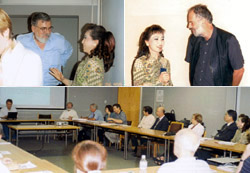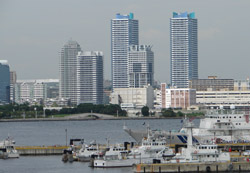Archilife Investingating Mission for SB05Tokyo (5)
|
SB05Tokyo國際會議考察團(5)  為了積極在國際間發聲與發揮影響力,在江哲銘評審委員與張桂鳳小姐的努力奔走下,於9月26日上午10點30分左右促成黃晉英秘書長與iiSBE秘書長Nils Larrson先生夫婦與理事Ronald Rovers先生的會晤,針對祐生參與iiSBE的角色與方式進行初步的溝通與討論,席間,黃晉英秘書長也詳盡解說共生化理念與作法和對方交換意見與想法。為了讓祐生更深入了解iiSBE的運作與現況,Nils Larrson先生與Ronald Rovers先生也邀請黃晉英秘書長參加當日下午即將召開的一年一度理事會議,以認識來自其他國家的理事代表。在iiSBE理事會議中,黃晉英秘書長不放過任何一隻可以交流的手,為的是要充分利用每一個機會,讓祐生站上國際舞台。  To speak to the world and to exert our influence, a meeting between Secretary General Huang Chin-ying and Mr. and Mrs. Nils Larrson, iiSBE Secretary General, and Mr. Ronald Rovers, iiSBE Chairperson, was finally arranged at about 10:30 am, September 26 with the efforts of Mr. Chiang Che-ming and Miss Chang Kuei-feng to discuss the role and manner of the foundation's participation in the iiSBE. At the meeting, Secretary General Huang Chin-ying explained in detail the concept and practice of symbiosis and exchanged opinions and ideas with the iiSBE. To let the foundation understand more about the operation and current status of the iiSBE, Larrson and Rovers invited Secretary General Huang Chin-ying to join the annual board meeting of the iiSBE in the following afternoon in order to make acquaintance with representatives from other countries. At the iiSBE board meeting, Secretary General Huang Chin-ying never wasted any chance to exchange with any directors of the iiSBE in order to make full use of every chance to let Archilife Research Foundation stand on the international stage. To speak to the world and to exert our influence, a meeting between Secretary General Huang Chin-ying and Mr. and Mrs. Nils Larrson, iiSBE Secretary General, and Mr. Ronald Rovers, iiSBE Chairperson, was finally arranged at about 10:30 am, September 26 with the efforts of Mr. Chiang Che-ming and Miss Chang Kuei-feng to discuss the role and manner of the foundation's participation in the iiSBE. At the meeting, Secretary General Huang Chin-ying explained in detail the concept and practice of symbiosis and exchanged opinions and ideas with the iiSBE. To let the foundation understand more about the operation and current status of the iiSBE, Larrson and Rovers invited Secretary General Huang Chin-ying to join the annual board meeting of the iiSBE in the following afternoon in order to make acquaintance with representatives from other countries. At the iiSBE board meeting, Secretary General Huang Chin-ying never wasted any chance to exchange with any directors of the iiSBE in order to make full use of every chance to let Archilife Research Foundation stand on the international stage.此外,為了讓祐生主導之熱帶及亞熱帶地區永續建築之微氣候設計的研討會於9月27日的Special Session有最完美的成果展示,李君如小姐與李彥頤先生不惜犧牲參觀橫濱的行程,留在飯店編製簡報。 Furthermore, to ensure the perfect results of the workshop 2 : Bio-Climatic Design of SB in Tropical & Subtropical Region held at the Special Session on September 27, Miss Li Chun-ju and Mr. Li Yen-yi gave up their trip to Yokohama to prepare the presentation at the hotel. 在此同時,其餘團員則參加SB05Tokyo大會安排之參觀行程,前往橫濱參觀大棧橋國際客輪碼頭旅客活動中心、橫濱中華街、紅磚屋倉庫及山下公園等。 At the same time, other members joined the Yokohama tour arranged by the organizers of SB05Tokyo to visit the Yokohama International Passenger Terminal, Yokohama Chinatown, Yokohama Red Brick Warehouse, and Yamashita Park.  經過一小時車程後,團員們到達第一站:大棧橋國際客輪碼頭旅客活動中心(Yokohama International Passenger Terminal),大棧橋國際客輪碼頭被稱為「美利堅碼頭」,是橫濱港的門戶。世界級豪華客輪伊利莎白女王號等皆在此停泊,是一個國際性的客輪碼頭。旅客活動中心造型為一鋼筋混凝土造郵輪船型建築,屋外走道及休息座椅係取材位於熱帶雨林的巴西所出產之檀木構築而成,屋頂上為用巴西檀木鋪陳的走道及鋪植草皮綠地的屋頂花園。室內同以巴西檀木做為主要裝修材料,並搭配大片落地窗做為自然採光及引景入室之用,此建築為日本最新之綠建築之一。其設計規劃概念為屋頂採覆土植栽以阻隔夏季直射太陽能量並做冬季保溫之用,不但增加人們活動、賞景空間,更增加基地綠覆率,達成保水節能之用。此外使用大片面積熱帶雨林自然木材披覆以減少非可自然分解材料的使用,另利用熱帶雨林木材產生之經濟效益來改善當地民眾生活品質,進而帶動產地當地樹木復育計畫,使自然資源能有效循環利用,達成永續建築及綠建築的目的。 經過一小時車程後,團員們到達第一站:大棧橋國際客輪碼頭旅客活動中心(Yokohama International Passenger Terminal),大棧橋國際客輪碼頭被稱為「美利堅碼頭」,是橫濱港的門戶。世界級豪華客輪伊利莎白女王號等皆在此停泊,是一個國際性的客輪碼頭。旅客活動中心造型為一鋼筋混凝土造郵輪船型建築,屋外走道及休息座椅係取材位於熱帶雨林的巴西所出產之檀木構築而成,屋頂上為用巴西檀木鋪陳的走道及鋪植草皮綠地的屋頂花園。室內同以巴西檀木做為主要裝修材料,並搭配大片落地窗做為自然採光及引景入室之用,此建築為日本最新之綠建築之一。其設計規劃概念為屋頂採覆土植栽以阻隔夏季直射太陽能量並做冬季保溫之用,不但增加人們活動、賞景空間,更增加基地綠覆率,達成保水節能之用。此外使用大片面積熱帶雨林自然木材披覆以減少非可自然分解材料的使用,另利用熱帶雨林木材產生之經濟效益來改善當地民眾生活品質,進而帶動產地當地樹木復育計畫,使自然資源能有效循環利用,達成永續建築及綠建築的目的。After an hour ride, we arrived at the first stop: Yokohama International Passenger Terminal. As the marine gateway of Japan, it is also known as the American Terminal where world-class deluxe passenger liners like the Queen Elizabeth have berthed there. The terminal is a RC structure in the shape of a liner. The outdoor corridor and seats are made of wood from the tropical rain forest in Brazil. The upper level hovers on the horizon with a continuous surface of grass and wooden walkways. The Brazilian wood is also the same material for indoor construction. A large French window is used for natural lighting and vistas. It is the one of the latest green buildings in Japan. The design and planning of the terminal include: use of plantation on the roof to block directly sunlight in summer and keep the building warm in winter. This not only provides more spaces for activities and sightseeing, but also increases the green coverage of the site for saving water and energy. Moreover, a large amount of wood from tropical rain forests is used to cover the building to reduce the use of decomposable materials. This has also helped to improve the living quality of people living in the Brazilian rain forest regions due to the purchase of wood from them. Thirdly, this could promote the forestation programs in Brazil for the effective recycling of natural resources and for accomplishing the goal of SB and GB. |

